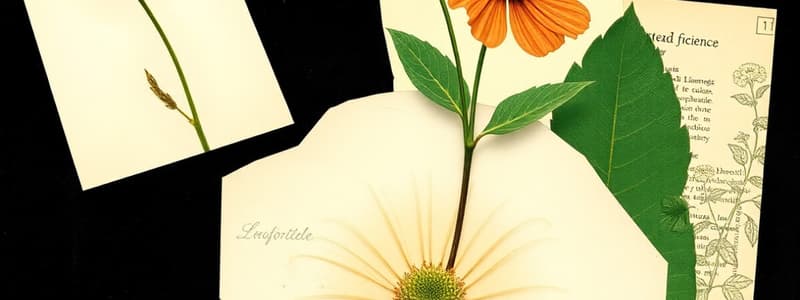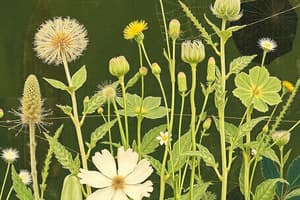Podcast
Questions and Answers
A farmer notices that a weed population in their field has become less susceptible to a particular herbicide after several years of consistent use. What is the most likely underlying cause of this phenomenon?
A farmer notices that a weed population in their field has become less susceptible to a particular herbicide after several years of consistent use. What is the most likely underlying cause of this phenomenon?
- The weed population has developed a learned behavioral adaptation to avoid contact with the herbicide.
- Genetic variations within the weed population have allowed some individuals to survive and reproduce, leading to a population-level resistance. (correct)
- The herbicide is being degraded more quickly in the soil due to changes in microbial activity.
- The herbicide is interacting with other chemicals in the soil, reducing its bioavailability to the weeds.
Integrated Weed Management (IWM) emphasizes a multifaceted approach. How does prioritizing non-chemical methods contribute to environmental stewardship?
Integrated Weed Management (IWM) emphasizes a multifaceted approach. How does prioritizing non-chemical methods contribute to environmental stewardship?
- IWM certification is solely based on the reduction of chemical inputs, regardless of ecological outcomes.
- Non-chemical methods are inherently more effective at eradicating weed populations completely.
- Non-chemical methods have no impact on herbicide resistance.
- Reducing herbicide use minimizes the potential for environmental harm and promotes biodiversity. (correct)
In the context of herbicide application, what critical factor determines the effectiveness of a pre-emergent herbicide?
In the context of herbicide application, what critical factor determines the effectiveness of a pre-emergent herbicide?
- The prevailing temperature and humidity levels post-application.
- The timing of application relative to weed seed germination and subsequent rainfall or irrigation. (correct)
- The developmental stage of the crop at the time of application.
- The specific type of nozzles used to spray the herbicide.
What is the primary mechanism by which weeds with non-target-site resistance (NTSR) overcome the effects of herbicides?
What is the primary mechanism by which weeds with non-target-site resistance (NTSR) overcome the effects of herbicides?
How does understanding the reproductive capacity and germination rates of weed species impact weed management strategies?
How does understanding the reproductive capacity and germination rates of weed species impact weed management strategies?
A farmer is implementing crop rotation as a cultural control method. What is the most important consideration when selecting crops for rotation to manage weed populations effectively?
A farmer is implementing crop rotation as a cultural control method. What is the most important consideration when selecting crops for rotation to manage weed populations effectively?
What is the most critical implication of herbicide volatility in agricultural practices?
What is the most critical implication of herbicide volatility in agricultural practices?
What is the role of 'indicator species' within the context of beneficial contributions of weeds?
What is the role of 'indicator species' within the context of beneficial contributions of weeds?
The 'critical period of crop-weed competition' (CPWC) is a key concept in weed management. How can focusing weed control during the CPWC optimize resources?
The 'critical period of crop-weed competition' (CPWC) is a key concept in weed management. How can focusing weed control during the CPWC optimize resources?
Why is understanding weed ecology, including life cycle and growth patterns, crucial for creating integrated weed management plans?
Why is understanding weed ecology, including life cycle and growth patterns, crucial for creating integrated weed management plans?
What is a key function of 'allelopathy' in biological weed control?
What is a key function of 'allelopathy' in biological weed control?
What role does 'record keeping' play in monitoring weed populations and herbicide effectiveness?
What role does 'record keeping' play in monitoring weed populations and herbicide effectiveness?
How does the practice of mulching contribute to cultural weed control?
How does the practice of mulching contribute to cultural weed control?
What is the primary reason for utilizing extension services in the context of Integrated Weed Management?
What is the primary reason for utilizing extension services in the context of Integrated Weed Management?
In the context of herbicide resistance, what does 'cross-resistance' refer to?
In the context of herbicide resistance, what does 'cross-resistance' refer to?
In the management of herbicide resistance, what is the intended purpose of rotating herbicides with different modes of action?
In the management of herbicide resistance, what is the intended purpose of rotating herbicides with different modes of action?
Besides soil stabilization, what is another beneficial contribution of weeds to the environment?
Besides soil stabilization, what is another beneficial contribution of weeds to the environment?
How does understanding the concept of 'rainfastness' influence practical herbicide application decisions?
How does understanding the concept of 'rainfastness' influence practical herbicide application decisions?
What best describes the stems of sedges?
What best describes the stems of sedges?
What is the most accurate description of leaves of grasses?
What is the most accurate description of leaves of grasses?
A farmer is considering using a post-emergent herbicide. What environmental factor is most critical in determining the effectiveness of this herbicide type?
A farmer is considering using a post-emergent herbicide. What environmental factor is most critical in determining the effectiveness of this herbicide type?
A farmer in a region with high rainfall is concerned about herbicide leaching. Which herbicide characteristic would be most desirable to minimize this risk?
A farmer in a region with high rainfall is concerned about herbicide leaching. Which herbicide characteristic would be most desirable to minimize this risk?
What is the primary ecological concern associated with weeds that have a high invasive potential?
What is the primary ecological concern associated with weeds that have a high invasive potential?
What is the importance of understanding the 'site of action' of commonly used herbicides in managing weed populations?
What is the importance of understanding the 'site of action' of commonly used herbicides in managing weed populations?
In the context of herbicide mobility, what is the most significant advantage of using herbicides that exhibit systemic action (mobility)?
In the context of herbicide mobility, what is the most significant advantage of using herbicides that exhibit systemic action (mobility)?
Flashcards
What are 'Weeds'?
What are 'Weeds'?
Plants considered unwanted and undesirable that compete with agricultural crops.
Characteristics of Weeds
Characteristics of Weeds
Weeds tend to display rapid stem growth, high reproductive output, and adaptability to varied environments.
Seed Dormancy (weeds)
Seed Dormancy (weeds)
A weed's ability to remain dormant in soil for extended periods and germinate when the conditions are favorable.
Allelopathy
Allelopathy
Signup and view all the flashcards
What are annual weeds?
What are annual weeds?
Signup and view all the flashcards
What are Biennial Weeds?
What are Biennial Weeds?
Signup and view all the flashcards
What are Perennial Weeds?
What are Perennial Weeds?
Signup and view all the flashcards
Resource competition with weeds
Resource competition with weeds
Signup and view all the flashcards
Reproductive Strategies of Weeds
Reproductive Strategies of Weeds
Signup and view all the flashcards
Weed Germination
Weed Germination
Signup and view all the flashcards
Dispersal Mechanisms of Weeds
Dispersal Mechanisms of Weeds
Signup and view all the flashcards
Weed Management
Weed Management
Signup and view all the flashcards
Timing of Weed Control
Timing of Weed Control
Signup and view all the flashcards
Crop competition
Crop competition
Signup and view all the flashcards
Invasive Potential (weeds)
Invasive Potential (weeds)
Signup and view all the flashcards
Crop rotation
Crop rotation
Signup and view all the flashcards
Herbicide Resistance Management
Herbicide Resistance Management
Signup and view all the flashcards
Critical Period of Crop-Weed Competition (CPWC)
Critical Period of Crop-Weed Competition (CPWC)
Signup and view all the flashcards
Pre-emergent Herbicides
Pre-emergent Herbicides
Signup and view all the flashcards
Post-emergent Herbicides
Post-emergent Herbicides
Signup and view all the flashcards
Rainfastness
Rainfastness
Signup and view all the flashcards
Leaching (herbicides)
Leaching (herbicides)
Signup and view all the flashcards
Volatility (herbicides)
Volatility (herbicides)
Signup and view all the flashcards
Herbicide Resistance
Herbicide Resistance
Signup and view all the flashcards
Target-Site Resistance (TSR)
Target-Site Resistance (TSR)
Signup and view all the flashcards
Study Notes
- Weeds are unwanted plants that compete with cultivated crops, disrupting land use and thriving in disturbed environments.
- Sustainable weed management integrates various methods to protect crop yields and the environment.
Characteristics of Weeds
- Rapid growth compared to cultivated crops.
- High reproductive output, producing numerous seeds.
- Seed dormancy allows seeds to remain dormant for extended periods.
- Adaptability to various environments and conditions.
- Allelopathy, where weeds exude chemicals that inhibit surrounding plant growth.
Gross Morphology: Grasses, Sedges, and Broadleaves
- Grasses belong to the family Poaceae.
- Grasses have round, hollow, jointed stems, long, narrow, parallel-veined leaves arising from nodes, fibrous root systems, and small, inconspicuous flowers grouped in spikelets.
- Examples of grasses: Leptochloa chinensis, Eleusine indica, and Echinocloa colona.
- Sedges belong to the family Cyperaceae.
- Sedges have triangular stems, leaves arranged in three ranks with parallel veins, dense fibrous root systems, and small, inconspicuous flowers grouped in spikelets or umbels.
- Examples of sedges: Cyperus rotundus, Cyperus iria, and Fimbristyllis miliaceae.
- Broadleaves have generally round or polygonal stems, broad leaves with reticulate venation, taproot or fibrous root systems, and typically larger, conspicuous flowers.
- Examples of broadleaves: Sphenoclea zeylanica, Amaranthus spinosus, and Portulaca oleraceae.
Life Cycle
- Annual weeds complete their life cycle within one year, such as crabgrass and barnyard grass.
- Biennial weeds take two years to complete their life cycle, like wild carrot and bull thistle.
- Perennial weeds live for multiple years and reproduce by seeds and vegetative means, such as cogon grass and Bermuda grass.
Habitats
- Weeds compete with crops in agricultural fields, with ornamental and vegetable plants in gardens, and thrive in disturbed soils along roadsides.
- Weeds grow in nutrient-poor and harsh waste areas.
- Weeds can invade and disrupt native plant communities in natural ecosystems.
Importance in Weed Competition
- Weeds compete with crops for resources like light, water, nutrients, and space.
- Weed competition leads to significant crop yield reduction.
- Weed control measures result in increased costs and reduced crop quality.
Biology and Behavior
- High seed production and vegetative propagation are reproductive strategies of weeds.
- Weed germination is adapted to various conditions.
- Weeds have rapid growth rates, often outcompeting crops.
- Weeds develop resistance to herbicides.
Dispersal Mechanisms
- Wind carries seeds, for example, cogon grass.
- Water disperses seeds or plant parts, such as barnyard grass.
- Animals spread seeds via attachment to fur or through ingestion and excretion.
- Human activity spreads weeds through contaminated equipment, seed stock, or soil movement.
Why Weeds Are Problems in Agriculture
- Weeds reduce crop yield by competing for essential resources.
- Weed management increases costs.
- Weeds harbor pests.
- Dense weed growth can impede harvesting equipment.
Beneficial Contributions of Weeds
- Weeds prevent soil erosion.
- Weeds provide habitats for wildlife and beneficial insects.
- Weeds can act as indicator species, reflecting soil conditions and environmental changes.
- Some weeds have medicinal properties like tawa-tawa and paragis.
- Weeds contribute organic matter to the soil when decomposed.
Reproductive Capacity of Selected Weeds
- Understanding seed production and germination rates helps design effective control strategies.
- Weeds like Amaranthus spinosus that produce a large number of seeds require more rigorous management to prevent seed spread.
- Knowing germination rates helps in timing herbicide or mechanical control interventions.
- Echinochloa crusgalli is a significant competitor in rice fields due to its high seed production and germination rates.
- Weeds with a high seed bank in the soil, such as Leptochloa chinensis, persist for years, requiring long-term management strategies.
- Species with high seed production and germination, like Rottboellia conchinchinensis, are more likely to become invasive.
- Understanding the reproductive capacity of species like Ipomoea triloba can guide decisions on managing invasive species to protect endangered plants.
Weed Management Impact
- Weed management is impacted through control strategies based on seed production and germination understanding.
- Agricultural impact is determined by competition affected by weed seed production and germination.
- Invasive potential is determined by seed production and germination.
Weed Control
- Habitat restoration in influenced by knowledge of the seed characteristics of invasive and native species.
- Conservation planning is influenced by knowledge of reproductive capacity of species.
- Ecological studies utilize reporductive traits to model population dynamics.
- Educating public about weed characteristics lead to proactive mangement.
Fundamental Guide to Creating Integrated Weed Management Plans
- Weed spectrum includes identifying weed species and understanding weed ecology.
- Cultural control involves crop rotation, cover crops, adjusted planting dates, and mulching.
- Mechanical control includes tillage, hand weeding, and mowing/cutting.
- Chemical control requires herbicide selection based on weed species, crop type, and growth stage.
- Herbicide use per crop: rice(butachlor, pretilachlor, cyhalofop, metamifop, pyribenzoxim), corn (glyphosate-tolerant corn varieties and atrazine), vegetables (selective herbicides), sugarcane (pre- and post-emergent herbicides), and banana (glyphosate).
- Herbicide resistance management involves rotating herbicides with different modes of action.
- Biological control involves introducing natural predators or using allelopathy.
- Monitoring and evaluation requires regular scouting, record keeping, and adjustments to the management plan.
- Integrated approaches combine cultural, mechanical, chemical, and biological methods.
- Education and training educate farmers on weed identification and IWM strategies.
- Environmental considerations involve minimizing herbicide use, buffer zones, and maintaining soil health.
Economic and Definition Considerations of CPWC
- Cost-effectiveness weighs control costs with benefits.
- Risk management considers herbicide resistance, crop damage, and environmental impact.
- The critical period of crop-weed competition (CPWC) is the time frame when weeds must be controlled to prevent yield loss.
- Yield protection and efficient resource use through weed management during CPWC.
- Cost reduction results from focusing on CPWC to reduce herbicide applications.
Herbicide Window of application
- Pre-emergent herbicides are applied before weed seeds germinate.
- Critical timing and adequate rainfall or irrigation are needed for pre-emergent herbicides.
- Post-emergent herbicides are applied after weeds emerge.
- Timing to apply when weeds are young and are actively growing.
- Weather influences efficacy of herbicides
Herbicide Mobility/Immobility
- Pre-emergent mobility applications include advantages of broader coverage but risks of leaching.
- Pre-emergent immobility applications include advantages of less leaching but requires precise application.
- Post-emergent mobility applications include advantages of systemic movement but influenced by weather.
- Post-emergent immobility applications include advantages of reduced risk to nearby crops but requires thorough coverage.
Rainfall, Sunlight, and Weather Effects
- Rainfastness is the time a herbicide needs to resist being washed off.
- Leaching is herbicide movement through the soil profile with water.
- Volatility is the tendency of a herbicide to vaporize and move.
Definition of Herbicide Resistance
- Herbicide resistance is the inherited ability of a weed population to survive herbicide application.
- Genetic variations within the weed population determine resistance.
Kinds of Herbicide Resistance
- Target-site resistance (TSR) involves genetic mutation preventing herbicide binding.
- Non-target-site resistance (NTSR) includes enhanced metabolism, reduced absorption, or sequestration.
- Cross-resistance is resistance to one herbicide conferring resistance to others.
- Multiple resistance is resistance to different modes of action.
Herbicide Overview
- Group 1 (A): ACCase inhibitors target lipid synthesis in grasses (e.g., Cyhalofop-butyl, fluazifop-butyl).
- Group 2 (B): ALS inhibitors block branched-chain amino acids (e.g., Pyribenzoxim, Bispyribac-sodium).
- Group 3 (K1): Microtubule assembly inhibitors interfere with cell division (e.g., Pendimethalin, Trifluralin).
- Group 5 (C1): Photosystem II inhibitors block electron transport (e.g., Atrazine, Diuron).
- Group 9 (G): EPSP synthase inhibitors block shikimic acid pathway (e.g., Glyphosate).
- Group 14 (E): PPO inhibitors disrupt cell membranes (e.g., Oxyfluorfen, Flumioxazim, Carfentrozone).
- Group 15 (K3): Inhibitors disrupt cell membrane formation (e.g., S-metolachlor, Dimethenamid).
- Group 22 (D): Photosystem electron diverters generate reactive oxygen species that damage cell membranes (e.g., Paraquat, Diquat).
- Group 27 (F2): HPPD inhibitors block carotenoid biosynthesis (e.g., Mesotrione, Tembotrione).
Common Herbicides
- Glyphosate targets EPSP Synthase
- Atrazine targets Photosystem II
- Pendimethalin targets Microtubule Assembly
- Clethodim targets ACCase
- 2,4-D is a Synthetic Auxin
- Metribuzin inhibits Photosystem II
- S-metolachlor inhibits VLCFA Synthesis
- Imazethapyr inhibits ALS Enzyme
- Paraquat is a Photosystem 1 Electron diverter
- Carfentrazone inhibits PPO enzyme
- Flumioxazim inhibits PPO enzyme
- Clomazone inhibits DOXP Synthase
- Mesotrione inhibits HPPD enzyme
- Bentazon inhibits Photosystem II
- Sulfentrazone inhibits PPO enzyme
Future of Weed Science and Technology
- Precision agriculture, new herbicide technologies, biological control, and advanced detection systems improve weed management.
Weed Photos
- Economically important lowland rice weeds: Leptochloa chinensis (Chinese sprangletop) and Echinochloa crusgalli (Barnyard grass).
- Additional economically important weeds: Echinochloa glabrescens (Barnyard grass), Echinochloa colona (Jungle rice), Ischaemum rugosum (Saramollagrass), and Ludwigia octovalvis (Mexican Primrose Willow).
- More economically important weeds: Ludwigia perennis (Indian Primrose), Sphenoclea zeylanica (Gooseweed), Monochoria vaginalis (Pickerel weed), and Pistia stratiotes (Water lettuce).
- Additional weeds: Cyperus iria (Rice flatsedge), Cyperus difformis (Small-flower umbrella sedge), and Fimbristylis miliaceae (Fimbry).
- Weeds in banana, corn, sugarcane, & vegetables: Cynodon dactylon (Bermuda grass), Eleusine indica (Goosegrass, wiregrass), and Rottboellia cochinchinensis (Itchgrass).
- More weeds: Echinochloa colona (Barnyard grass), Brachiaria distachya (Armgrass millet), and Ipomoea triloba (Three-lobe morning glory).
- Additional weeds: Ageratum conyzoides (Billy goat weed), Cleome rutidosperma (Spindle top), and Amaranthus spinosus (Spiny amaranth).
- Additional weeds: Portulaca oleracea (Common purslane), Cyperus rotundus (Purple nutsedge), and Trianthema portulacastrum (Horse purslane).
- Additional weeds: Cyperus kyllingia (Spike sedge), Galinsoga quadriradiata (hairy galinsoga), and Ageratum conyzoides (billy goat weed).
- Other weeds: Spilanthes acmella (toothache plant), Crassocephalum crepidioides (thickhead/fireweed), and Commelina benghalensis (dayflower).
- Final weeds: Portulaca oleracea (common purslane), Oxalis corymbosa (pink shamrock/sleeper weed), and Bidens pilosa (blackjack/beggarticks).
Studying That Suits You
Use AI to generate personalized quizzes and flashcards to suit your learning preferences.




